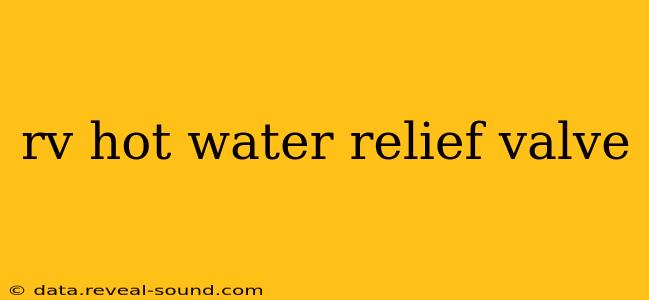Recreational vehicles (RVs) rely on hot water heaters to provide comfortable living, but safety is paramount. A crucial component ensuring this is the RV hot water heater relief valve. This valve acts as a critical safety mechanism, preventing potentially dangerous pressure buildup within the water heater tank. Understanding its function, maintenance, and troubleshooting is vital for every RV owner. This guide provides a comprehensive overview, addressing common questions and concerns.
What is an RV Hot Water Heater Relief Valve?
The RV hot water heater relief valve is a pressure-relief device designed to automatically release excess pressure from your RV's water heater tank. This pressure can build up due to several factors, including overheating, expansion of water due to temperature increases, and even external pressure changes. If the pressure exceeds a predetermined limit (typically 150 PSI), the valve opens, releasing hot water and reducing the pressure to a safe level. This prevents the tank from rupturing, potentially causing significant damage and injury.
How Does an RV Hot Water Heater Relief Valve Work?
The valve utilizes a simple, yet effective mechanism. Inside the valve is a spring-loaded mechanism that holds a valve stem closed under normal pressure. As pressure inside the water heater increases, it pushes against the spring. Once the pressure surpasses the valve's set point, the spring is overcome, and the valve stem opens, releasing hot water until the pressure is reduced. The valve then automatically closes once the pressure returns to a safe level.
Why is it Important to Regularly Check My RV Hot Water Heater Relief Valve?
Regular inspection of your RV hot water heater relief valve is crucial for safety. A malfunctioning valve can lead to dangerous pressure buildup, potentially resulting in a tank rupture. Regular checks ensure the valve is functioning correctly and prevents potential hazards. This includes checking for leaks, corrosion, and ensuring the valve operates freely.
How Often Should I Check My RV Hot Water Heater Relief Valve?
While there's no universally prescribed frequency, it's recommended to inspect your RV hot water heater relief valve at least once a year, or before each extended RV trip. More frequent checks may be necessary depending on the age of your water heater and its usage.
How Do I Test My RV Hot Water Heater Relief Valve?
Testing your RV hot water heater relief valve is a simple process that ensures it's functioning correctly. To do so:
- Locate the valve: It's typically located on the top of the water heater tank.
- Manually lift the lever: Gently lift the lever on the valve. If the valve is working properly, hot water should flow freely.
- Check for leaks: Inspect the valve for any leaks when the lever is both open and closed.
Important Note: Always direct the released water away from yourself and any flammable materials. The water will be hot!
What Should I Do If My RV Hot Water Heater Relief Valve is Leaking?
A leaking RV hot water heater relief valve indicates a potential problem. This could be due to a faulty valve, excessive pressure in the water heater system, or a problem within the water heater itself. If you notice a leak, do not ignore it. This necessitates immediate action. Contact a qualified RV technician for diagnosis and repair. Continuing to use the water heater with a leaking relief valve poses a significant safety risk.
Can I Replace My RV Hot Water Heater Relief Valve Myself?
Replacing an RV hot water heater relief valve is a relatively straightforward task for those comfortable with basic plumbing. However, if you are unsure about the process, it’s always best to consult a professional. Improper installation can lead to further problems and compromise safety. Be sure to obtain a replacement valve that matches the specifications of your existing valve.
What Causes My RV Hot Water Heater Relief Valve to Continuously Discharge?
A continuously discharging RV hot water heater relief valve points to a persistent pressure issue within the water heater system. This could be caused by:
- A faulty temperature/pressure relief valve: The valve itself may be malfunctioning and needs replacing.
- A faulty pressure relief valve: The valve might not be shutting off properly.
- Overheating: Check the water heater's thermostat and burner for proper functioning.
- Excessive pressure: A blockage in the water lines could create excessive pressure.
Addressing a continuously discharging valve requires careful investigation and potential repair or replacement of components. Consult an RV technician to diagnose and fix the underlying issue.
This comprehensive guide offers valuable insights into the function, maintenance, and troubleshooting of your RV hot water heater relief valve. Remember, prioritizing safety ensures worry-free enjoyment of your RV adventures. Always address any concerns promptly and seek professional assistance when needed.
